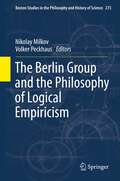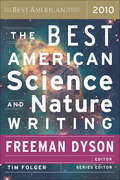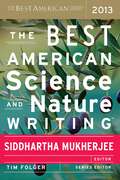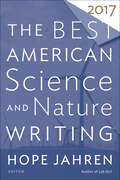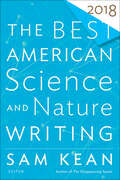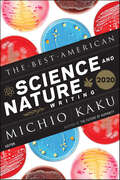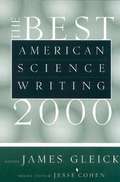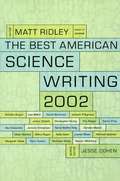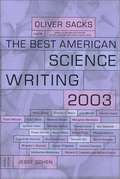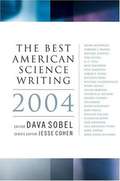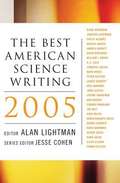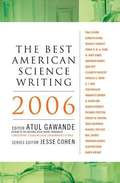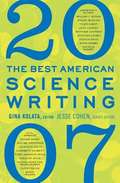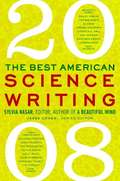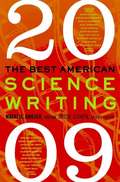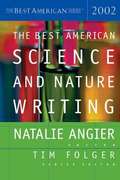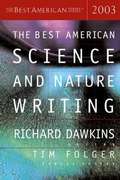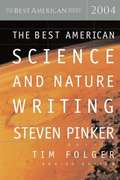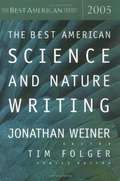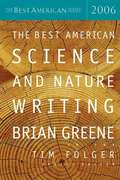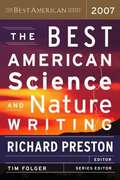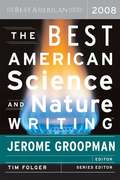- Table View
- List View
The Berlin Group and the Philosophy of Logical Empiricism
by Nikolay Milkov Volker PeckhausThe Berlin Group for scientific philosophy was active between 1928 and 1933 and was closely related to the Vienna Circle. In 1930, the leaders of the two Groups, Hans Reichenbach and Rudolf Carnap, launched the journal Erkenntnis. However, between the Berlin Group and the Vienna Circle, there was not only close relatedness but also significant difference. Above all, while the Berlin Group explored philosophical problems of the actual practice of science, the Vienna Circle, closely following Wittgenstein, was more interested in problems of the language of science. The book includes first discussion ever (in three chapters) on Walter Dubislav's logic and philosophy. Two chapters are devoted to another author scarcely explored in English, Kurt Grelling, and another one to Paul Oppenheim who became an important figure in the philosophy of science in the USA in the 1940s-1960s. Finally, the book discusses the precursor of the Nord-German tradition of scientific philosophy, Jacob Friedrich Fries.
The Best American Science And Nature Writing 2010 (The Best American Series)
by Freeman DysonTwenty-eight of the best pieces of science and nature writing in America in a collection edited by the renowned physicist and public intellectual.The Best American series is the premier annual showcase for the country’s finest short fiction and nonfiction. Each volume’s series editor selects notable works from hundreds of periodicals. A special guest editor, a leading writer in the field, then chooses the best twenty or so to publish. This unique system has made the Best American series the most respected—and most popular—of its kind.The Best American Science and Nature Writing 2010 includes:Timothy FerrisTim FlanneryJane GoodallPhilip GourevitchElizabeth KolbertJonah LehrerKathleen McGowanFelix SalmonTom WolfeAnd others
The Best American Science And Nature Writing 2013 (Best American)
by Tim FolgerPulitzer Prize–winning author Siddhartha Mukherjee, a leading cancer physician and researcher, selects the year’s top science and nature writing from journalists who dive into their fields with curiosity and passion, delivering must-read articles from a wide array of fields.
The Best American Science And Nature Writing 2017 (The Best American Series)
by Hope Jahren, Tim FolgerTwenty-four “outstanding” pieces of American science & nature writing, edited by a renowned scientist and bestselling author (Publishers Weekly).“Science is both essential and frivolous, jubilant and despairing, lovely and brutal, perfect and broken—all at the same time—just like the scientists who fashion it,” writes Hope Jahren in her introduction to The Best American Science and Nature Writing 2017. The pieces honored in this collection celebrate astonishing wonders—from our public lands to a new way of tasting food we eat—and investigate grave perils, like the rapid progression of climate change, air pollution, and more. They show us the beauty and innovation of our planet, and how urgently we must fight to protect it from all those who take it for granted.The Best American Science and Nature Writing 2017 includes:Elizabeth KolbertDavid EpsteinMaria KonnikovaJon MooallemTom KizziaNicola TwilleyAnd others
The Best American Science And Nature Writing 2018 (The Best American Series)
by Sam Kean, Tim FolgerA collection of the year’s best science and nature writings, selected by New York Times bestselling author Sam Kean.“This is one of the most exciting times in the history of science,” Sam Kean proclaims in his introduction to The Best American Science and Nature Writing 2018. “Things aren’t perfect by any means. But there are more scientists making more discoveries in more places about more things than ever before.” The twenty-six pieces assembled here chart the full spectrum of those discoveries. From the outer reaches of space, to the mysteries of the human mind, to the changing culture in labs and universities across the nation, we see time and again the sometimes rocky, sometimes revelatory road to understanding, and along the way catch a glimpse of all that’s left to learn.The Best American Science and Nature Writing 2018 includes contributions by Ross Andersen * Jacqueline Detwiler * Sophie Brickman * John Lanchester * Siddharta Mukherjee * Kim Todd * Douglas Fox * J. B. MacKinnon * Barack Obama * David Roberts * Ceridwen Dovey * Caitlin Kuehn * Paul Kvinta * Joshua Rothman * Christopher Solomon * Kayla Webley Adler * Rachel Leven * Rebecca Boyle * Kenneth Brower * Susannah Felts * Steven Johnson * Elena Passarello * Ed Yong * Barbara Bradley Hagerty * Eva Holland * Kathryn Schulz
The Best American Science And Nature Writing 2020 (The Best American Series)
by Michio Kaku Jaime GreenAn outstanding collection guest-edited by the groundbreaking physicist and New York Times–bestselling author of Quantum Supremacy.“Scientists and science writers have a monumental task: making science exciting and relevant to the average person, so that they care,” writes renowned American physicist Michio Kaku. “If we fail in this endeavor, then we must face dire consequences.” From the startlingly human abilities of AI, to the devastating accounts of California’s forest fires, to the impending traffic jam on the moon, the selections in this year’s Best American Science and Nature Writing explore the latest mysteries and marvels occurring in our labs and in nature. These gripping narratives masterfully translate the work of today’s brightest scientists, offering a clearer view of our world and making us care.
The Best American Science And Nature Writing 2021 (The Best American Series)
by Ed Yong, Jaime GreenNew York Times best-selling author and renowned science journalist Ed Yong compiles the best science and nature writing published in 2020. &“The stories I have chosen reflect where I feel the field of science and nature writing has landed, and where it could go,&” Ed Yong writes in his introduction. &“They are often full of tragedy, sometimes laced with wonder, but always deeply aware that science does not exist in a social vacuum. They are beautiful, whether in their clarity of ideas, the elegance of their prose, or often both.&” The essays in this year&’s Best American Science and Nature Writing brought clarity to the complexity and bewilderment of 2020 and delivered us necessary information during a global pandemic. From an in-depth look at the moment of the virus&’s outbreak, to a harrowing personal account of lingering Covid symptoms, to a thoughtful analysis on how the pandemic will impact the environment, these essays, as Yong says, &“synthesize, evaluate, dig, unveil, and challenge,&” imbuing a pivotal moment in history with lucidity and elegance. THE BEST AMERICAN SCIENCE AND NATURE WRITING 2021 INCLUDES • SUSAN ORLEAN • EMILY RABOTEAU • ZEYNEP TUFEKCI • HELEN OUYANG • HEATHER HOGAN BROOKE JARVIS • SARAH ZHANG and others
The Best American Science Writing 2000
by James GleickThis offers glimpses of new realms of discovery and thought, exploring scientific territory that is unfamiliar to most of us, and an introduction to a collection of science writers and thinkers.
The Best American Science Writing 2001
by Timothy FerrisThis anthology presents 22 essays and a poem (by John Updike) published during 2001 in various publications, and an introduction by guest editor/science writer Ferris. Among the contributors: Freeman Dyson, Stephen Jay Gould, Tracy Kidder; topics run the gamut.
The Best American Science Writing 2002
by Alan Lightman Matt RidleyIf, as Matt Ridley suggests, science is simply the search for new forms of ignorance, then perhaps it follows that with science's advances come new questions. Will human genetic engineering become commonplace? Will human cloning ever be safe? Are there many universes? How much will the climate change during the coming century? The Best American Science Writing 2002 gathers top writers and scientists covering the latest developments in the fastest-changing, farthest-reaching scientific fields, such as medicine, genetics, computer technology, evolutionary psychology, cutting-edge physics, and the environment. Among this year's selections: In "The Made-to-Order Savior," Lisa Belkin spotlights two desperate families seeking an unprecedented cure by a medically and ethically unprecedented means -- creating a genetically matched child. Margaret Talbot's "A Desire to Duplicate" reveals that the first human clone may very likely come from an entirely unexpected source, and sooner than we think. Michael Specter reports on the shock waves rippling through the field of neuroscience following the revolutionary discovery that adult brain cells might in fact regenerate ("Rethinking the Brain"). Christopher Dickey's "I Love My Glow Bunny" recounts with sly humor a peculiar episode in which genetic engineering and artistic culture collide. Natalie Angier draws an insightful contrast between suicide terrorists and rescue workers who risk their lives, and finds that sympathy and altruism have a definite place in the evolution of human nature, David Berlinski's "What Brings a World into Being?" ponders the idea of biology and physics as essentially digital technologies, exploring the mysteries encoded in the universe's smallest units, be they cells or quanta. Nicholas Wade shows how one of the most controversial books of the year, The Skeptical Environmentalist, by former Greenpeace member and self-described leftist Bjorn Lomborg, debunks some of the most cherished tenets of the environmental movement, suggesting that things are perhaps not as bad as we've been led to believe. And as a counterpoint, Darcy Frey's profile of George Divoky reveals a dedicated researcher whose love of birds and mystery leads to some sobering discoveries about global warming and forcefully reminds us of the unsung heroes of science: those who put in long hours, fill in small details, and take great trouble. In the end, the unanswered questions are what sustain scientific inquiry, open new frontiers of knowledge, and lead to new technologies and medical treatments. The Best American Science Writing 2002 is a series of exciting reports from science's front lines, where what we don't know is every bit as important as what we know.
The Best American Science Writing 2003
by Oliver SacksIn his introduction to The Best American Science Writing 2003, Dr. Oliver Sacks, whom the New York Times has called "the poet laureate of medicine," writes that "the best science writing ... cannot be completely 'objective' -- how can it be when science itself is so human an activity? -- but it is never self-indulgently subjective either. It is, at best, a wonderful fusion, as factual as a news report, as imaginative as a novel." It is with this definition of "good" science writing in mind that Dr. Sacks has selected the twenty-five extraordinary pieces that make up the latest installment of this acclaimed annual. This year, Peter Canby travels into the heart of remote Africa to track a remarkable population of elephants; Atul Gawande shows us the way doctors learn their skills by performing supposedly routine procedures on unsuspecting patients. With candor and tenderness, Floyd Skloot observes the toll Alzheimer's disease is taking on his ninety-one-year-old mother, and is fascinated by the memories she retains. Marcelo Gleiser asks: If we are the universe's sole intelligent species, then what must we do to be good citizens of the cosmos? Natalie Angier writes about the challenge of traveling to distant stars. Gunjan Sinha explores the mating behavior of the common prairie vole and what it reveals about the human pattern of monogamy. Michael Klesius attempts to solve what Darwin called "an abominable mystery": How did flowers originate? Lawrence Osborne tours a farm where a genetically modified goat produces the silk of spiders in its milk. Joseph D'Agnese visits a home for retired medical research chimps. And in the collection's final piece, Richard C. Lewontin and Richard Levins reflect on how the work of Stephen Jay Gould demonstrated the value of taking a radical approach to science. As this series firmly attests, science writing has achieved a central place in our culture, and one can posit that the reason why has to do with the special thrill of discovery that a cogent piece of science writing can elicit. As Dr. Sacks writes of Stephen Jay Gould -- to whose memory this year's anthology is dedicated -- an article of his "was never predictable, never dry, could not be imitated or mistaken for anybody else's." The same can be said of all of the writing contained in contributions to this diverse collection "that can be enjoyed by laymen, scientists, and writers alike" (Nature).
The Best American Science Writing 2004
by Dava Sobel Jesse CohenWhat makes the articles found in The Best American Science Writing 2004 "the best"? As Dava Sobel, best-selling author of Longitude and Galileo's Daughter, writes in her introduction, "First and most important, all are extremely well written. This sounds obvious, and it is, but for me it means the pieces impart genuine pleasure via the writers' choice of words and the rhythm of their phrases... 'I wish I'd written that,' was my own frequent reaction to the articles I ultimately chose." This year, Jennifer Kahn's "Stripped for Parts" was selected as the lead story because, as Sobel reveals, "it begins with one of the most arresting openings I have ever read. " In "Columbia's Last Flight," William Langewiesche recounts the February 1, 2003, space shuttle tragedy, along with the investigation into the nationwide complacency that brought the ship down. K. C. Cole's "Fun with Physics" is a profile of astrophysicist Janet Conrad that blends her personal life with professional activity. In "Desperate Measures," the doctor and writer Atul Gawande profiles the surgeon Francis Daniels Moore, whose experiments in the 1940s and '50s pushed medicine harder and farther than almost anyone had contemplated. Also included is a poem by the legendary John Updike, "Mars as Bright as Venus." The collection ends with Diane Ackerman's "ebullient" essay "We Are All a Part of Nature. " Together these twenty-three articles on a wide range of today's most current topics in science -- from biology, physics, biotechnology, and astronomy, to anthropology, genetics, evolutionary theory, and cognition -- represent the full spectrum of scientific writing from America's most prominent science authors, proving once again that "good science writing is evidently plentiful" ( Scientific American ).
The Best American Science Writing 2005
by Alan LightmanToday's most prominent thinkers provide enlightening insight into some of the most important and cutting-edge topics in the field in this acclaimed series.
The Best American Science Writing 2006
by Atul GawandeTogether these twenty-one articles on a wide range of today's most leading topics in science, from Dennis Overbye, Jonathan Weiner, and Richard Preston, among others, represent the full spectrum of scientific inquiry, proving once again that good science writing is evidently plentiful.
The Best American Science Writing 2007
by Gina KolataProvocative and engaging, this collection brings together the premiere science writing of the year. The Best American Science Writing 2007 is a compelling anthology of our most advanced, and most relevant, scientific inquiries.
The Best American Science Writing 2008
by Sylvia NasarEdited by Sylvia Nasar, bestselling author of A Beautiful Mind and former economics correspondent for the New York Times, The Best American Science Writing 2008 brings together the premiere science writing of the year. Distinguished by the foremost voices and publications--among them Pulitzer Prize-winner Amy Harmon, Nobel Prize-winner Al Gore, and award-winning and bestselling author Oliver Sacks--this anthology is a comprehensive overview of our most advanced and most relevant scientific inquiries.
The Best American Science Writing 2009
by Natalie AngierDistinguished by new and impressive voices as well as some of the foremost names in science writing--Oliver Sacks and Atul Gawande among them--this anthology provides a comprehensive overview of where science has taken us--and where it is headed.
The Best American Science and Nature Writing 2000
by David QuammenWith the inaugural volume of THE BEST AMERICAN SCIENCE AND NATURE WRITING, Houghton Mifflin showcases the finest writing of the past year on subjects of ever-increasing interest to readers. Guest editor David Quammen and series editor Burkhard Bilger have assembled a remarkable group of essays that originally appeared in periodicals from National Geographic, Science, and The New Yorker to Puerto del Sol and DoubleTake. Among the acclaimed writers represented are Natalie Angier on "Men, Women, Sex, and Darwin," Peter Matthiessen exploring "The Island at the End of the Earth," Richard Preston considering "The Demon in the Freezer," and Oliver Sacks remembering the "Brilliant Light" of his boyhood. Also including work by such literary lights as Anne Fadiman, Edward Hoagland, and Cullen Murphy, this volume presents selections bound together by their timelessness.
The Best American Science and Nature Writing 2002
by Natalie AngierThis book has a collection from the best and brightest writers on science and nature exploring the topics like Islamic science, disappearing cancers and many such stimulating subjects.
The Best American Science and Nature Writing 2003
by Richard Dawkins Tim FolgerThe subjects include astronomy's new stars, archaeology, the Bible, 'terminal' ice, memory faults, Oliver Sacks, low carb diets, missile defense, the war on coyotes, and more.
The Best American Science and Nature Writing 2004
by Steven PinkerThe Best American Science and Nature Writing 2004, edited by Steven Pinker, is another "provocative and thoroughly enjoyable [collection] from start to finish" (Publishers Weekly). Here is the best and newest on science and nature.
The Best American Science and Nature Writing 2005
by Tim Folger Jonathan WeinerThe Best American series has been the premier annual showcase for the country's finest short fiction and nonfiction since 1915. Each volume's series editor selects notable works from hundreds of periodicals. A special guest editor, a leading writer in the field, then chooses the very best twenty or so pieces to publish. This unique system has made the Best American series the most respected -- and most popular -- of its kind. The Best American Science and Nature Writing 2005 includes pieces by Natalie Angier, Jared Diamond, Timothy Ferris, Malcolm Gladwell, Jerome Groopman, Bill McKibben, Sherwin B. Nuland, Jeffrey M. O'Brien, Oliver Sacks, Michael J. Sandel, William Speed Weed, and others.
The Best American Science and Nature Writing 2006
by Brian GreeneBestselling author Brian Greene edits this year's volume of the finest science and nature writing. Contributors include Walter Kirn, Ron Rosenbaum, Jeffrey Toobin, and Oliver Sacks as well as many others.
The Best American Science and Nature Writing 2007
by Richard Preston Tim FolgerThis collection has a range of topics, from the farthest reaches of space to the world around us and to the secrets hidden in our own bodies. Some harmful impacts of science on the natural world is also mentioned.
The Best American Science and Nature Writing 2008
by Jerome GroopmanBest-selling author and staff writer for The New Yorker Jerome Groopman, M.D., edits this year's volume of the finest science and nature writing. From prize-winning favorites, this is a "wonderful series where students find plenty of inspiration"
